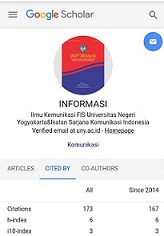Tanoker community as a counter culture movement to communicate traditional games in Ledokombo Jember Indonesia
DOI:
https://doi.org/10.21831/informasi.v52i2.49039Keywords:
Tanoker Community, Communication Culture, Culture Movement, Video Games.Abstract
Tanoker is one of the traditional games in Indonesia which is one of the cultural heritages whose existence must be protected and preserved. The Tanoker community has begun to actively promote this traditional game to be introduced to the community. The purpose of this study is to examine the Tanoker community in their efforts to prevent the negative impact of online gaming culture through traditional games. This type of research using in this study is a qualitative approach with ethnographic methods was used in this study as well as by analyzing the text and interview results. The results showed that the Tanoker community played a role in communicating the traditional game of tanoker in the community as a counter culture movement to communicate traditional games in Ledokombo Jember. The Tanoker Ledokombo community is not anti-modern games, some of them who come with cell phones, there are only rules when activities are being carried out, their cell handphones cannot be used. This is where good values are internalized in children Tanoker aims to contribute solving problems, especially preparing children to live healthy, fostering a cooperative, discipline, and sportive sense, being smart and having prosperous lives.
References
Ahlstrom, M., Lundberg, N. R., Zabriskie, R., Eggett, D., & Lindsay, G. B. (2012). Me, my spouse, and my avatar: The relationship between marital satisfaction and playing massively multiplayer online role-playing games (MMORPGs). Journal of Leisure Research, 44(1), 1-22.
Alverson, B. (2016). Game changers: Books based on video games and their characters have broad appeal. School Library Journal, 6, 11-30.
Becker-Olsen, K. L., & Norberg, P. A. (2014). Caution, animated violence: Assessing the efficacy of violent video game ratings. In Advertising and Violence (pp. 179-194). Routledge.
Castells, M. (2009). The rise of the network society volume 1 with a new preface. Book The Rise of the network society, Volume 1, With a new preface.
Borja, J., & Castells, M. (2013). Local and global: the management of cities in the information age. Routledge.
Chen, K., Chen, J. V., & Ross, W. H. (2012). Antecedents of online game dependency: The implications of multimedia realism and uses and gratifications theory. In Cross-Disciplinary Models and Applications of Database Management: Advancing Approaches (pp. 176-208). IGI Global.
Choi, Y. K., Lee, S. M., & Li, H. (2013). Audio and visual distractions and implicit brand memory: a study of video game players. Journal of Advertising, 42(2-3), 219-227.
Choi, Y. K., Lee, S. M., & Li, H. (2013). Audio and visual distractions and implicit brand memory: a study of video game players. Journal of Advertising, 42(2-3), 219-227.
Fitria, F. (2018, November). Development of motorized stimulation models based on traditional Gobak sodor game. In 4th International Conference on Early Childhood Education. Semarang Early Childhood Research and Education Talks (SECRET 2018) (pp. 87-90). Atlantis Press.
Ivan, L. (2022). Interpersonal communication in the information age: Opportunities and disruptions. American Behavioral Scientist, 00027642221092801.
Jon, D., & Kennedy., H. W. (2006). Game cultures. Computer games as new media.
Juariyah, J. (2018). Pengalaman bermain video games sebagai kegiatan leisure class middle lower remaja kampung Tanoker. MEDIAKOM, 1(2).
Mandoki, K. (2016). Everyday aesthetics: Prosaics, the play of culture and social identities. Routledge.
Matteson, A. (2017). Build games with bloxels: with cheery blocks, kids can design their own video games, coding not required. School Library Journal, 63(5).
Mäyrä, F. (2008). An introduction to game studies. Sage.
Paul, C. A. (2012). Wordplay and the discourse of video games: Analyzing words, design, and play. Routledge.
Sheremeta, R. M., & Zhang, J. (2014). Three"player trust game with insider communication. Economic Inquiry, 52(2), 576-591.
Shi, W., Corriveau, J. P., & Agar, J. (2014). Dead reckoning using play patterns in a simple 2D multiplayer online game. International Journal of Computer Games Technology, 2014.
Sutarto, A. P. (2002). Budaya lokal, dan prahara informasi dalam menjinakkan globalisasi: tentang peran strategis produk-produk budaya lokal. Kompyawisda & Universitas Jember.
Velayati, S. (2014). Komunitas Tanoker Ledokombo: Pendorong perubahan sosial pedesaan melalui pendekatan budaya di Kecamatan Ledokombo, Kabupaten Jember, Jawa Timur (Doctoral dissertation, Brawijaya University).
Terlutter, R., & Capella, M. L. (2013). The gamification of advertising: analysis and research directions of in-game advertising, advergames, and advertising in social network games. Journal of advertising, 42(2-3), 95-112.
Thomas, K. D., & Levent, R. F. (2012). Does the endorsement of traditional masculinity ideology moderate the relationship between exposure to violent video games and aggression?. The Journal of Men's Studies, 20(1), 47-56.
Zulkarnain, I. (2014). "Playable" nationalism: Nusantara online and the "gamic" reconstructions of national history. Sojourn: Journal of Social Issues in Southeast Asia, 29(1), 31-62.
Downloads
Published
How to Cite
Issue
Section
Citation Check
License
Authors who publish with this journal agree to the following terms:
- Authors retain copyright and grant the journal right of first publication with the work simultaneously licensed under a Creative Commons Attribution License that allows others to share the work with an acknowledgement of the work's authorship and initial publication in this journal.
- Authors are able to enter into separate, additional contractual arrangements for the non-exclusive distribution of the journal's published version of the work (e.g., post it to an institutional repository or publish it in a book), with an acknowledgement of its initial publication in this journal.
- Authors are permitted and encouraged to post their work online (e.g., in institutional repositories or on their website) prior to and during the submission process, as it can lead to productive exchanges, as well as earlier and greater citation of published work (See The Effect of Open Access).











